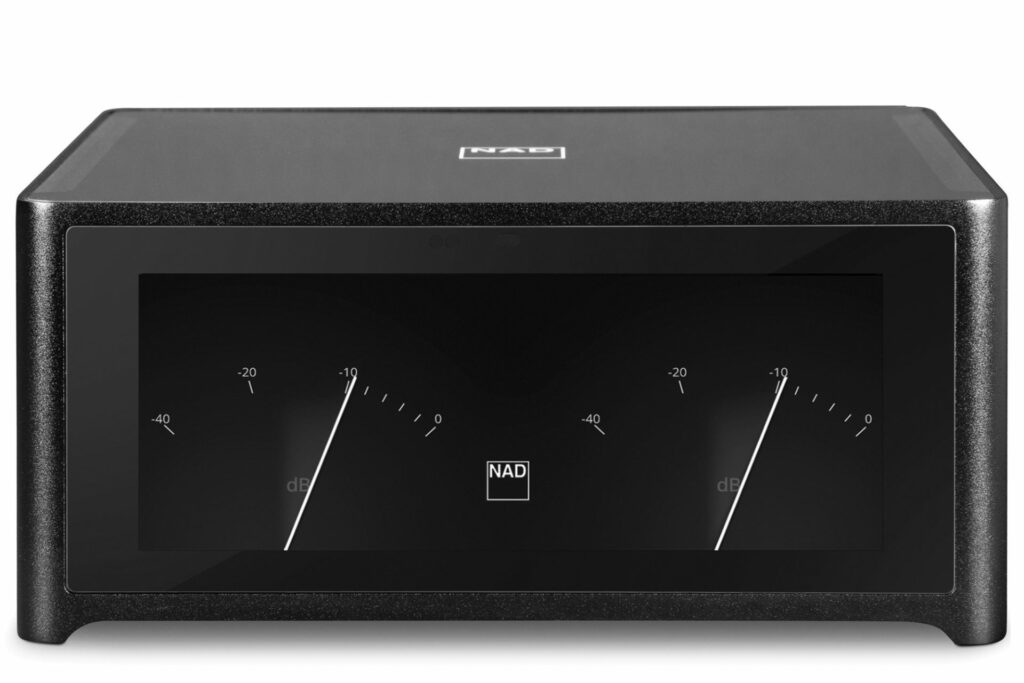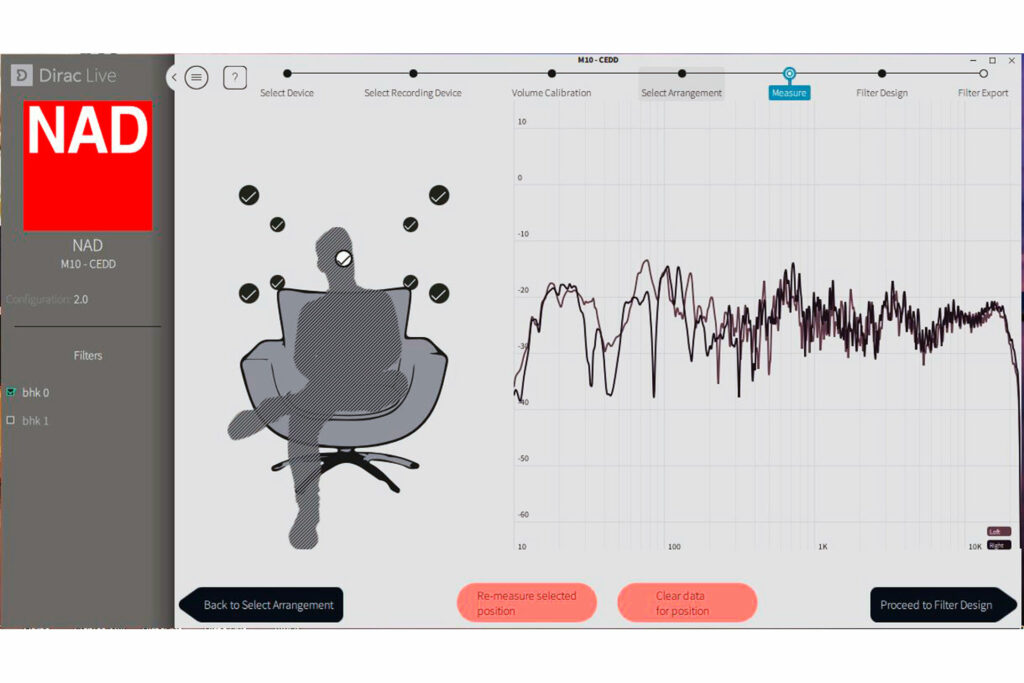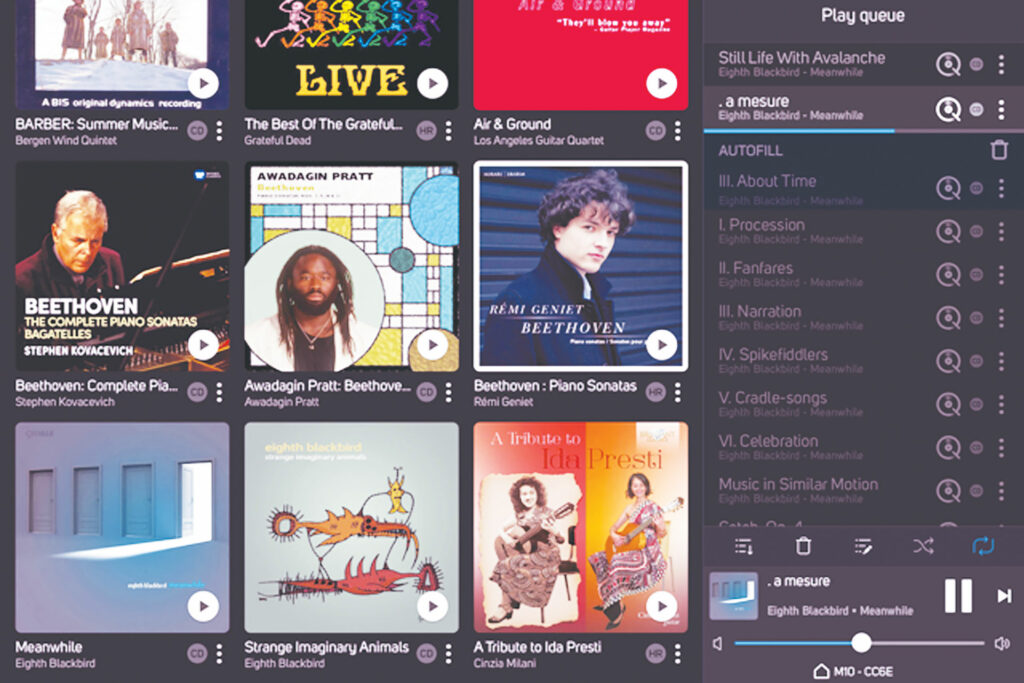(originally published in The Audiophile Voice Magazine in print, December 2019)
As I have mentioned before in recent reviews, modern audio is increasingly a world of streaming music. Now, as the subject for this review, here is another interesting new device from NAD Master M10 (buy at Crutchfield). The M10 is a complete, single unit that, when connected to a pair of speakers and a suitable WIFI, can stream Internet radio and music services. Additionally, it has analog and digital inputs, Bluetooth, and many other attractions. Here is more complete list of features and notable aspects:

BluOS streaming amplifier; hybrid digital nCore (is Hypex nomenclature for their switching amp technology) amplifier; continuous power rating is 100 watts into 8- or 4-ohm loads; dynamic power is rated as 160 watts into an 8-ohm load or 300 watts into a 4-ohm load; DAC is a 32-bit/384 kHz ESS Sabre; 1-GHz ARM CORTEX A9 processor; Dirac Live room correction; color thin-film transistor display; supports Amazon Alexa voice-control applications; AirPlay 2 Integration; supports Siri Voice Assistant via AirPlay 2; two-way Qualcomm aptX HD Bluetooth; NFC Bluetooth pairing for compatible smart devices; BluOS multi-room compatible; Gigabit Ethernet; HDMI eARC protocol, USB Type A input; stereo line inputs; coax/optical inputs; preamp-level output; dual-mono subwoofer outputs; IR Input; 12-v trigger output; apps for iOS, Android, Mac OS, Windows, Crestron, Control4, RTI, URC, Elan, Lutron, and iPort. A wide variety of premium music services are supported in various applications, including Amazon, Spotify, Tidal, TuneIn, Napster, Deezer, Qobuz, and many others.
More NAD-Related Audiophile Resources
- The NAD C 3050 integrated amp won the Audiophile Component of the Year review from FutureAudiophile.com in 2023. Read the review here.
- Read more integrated amp reviews in FutureAudiophile.com’s archives.
- Read more DAC and streamer reviews in FutureAudiophile.com’s archives.
- Read the NAD C 558 Turntable reviewed here by Andrew Dewhirst.
- Read a review of the NAD C 338 Hybrid Digital DAC/Amp here.
- Read Greg Handy’s review of the NAD C 700 BluOS Streaming Amp reviewed.

Setup of the NAD Master M10 Integrated Amp
When I unpacked the NAD M10, I was most impressed with the packing. There was a very nice box, with foam liners and a black bag surrounding the unit. This is very first class on NAD’s part. My first impression was that the NAD M10 does have a very comprehensive bunch of features – features that I intend to check out and experience to the max. And present to you readers.
Starting on the rather busy rear panel, from left to right and along the bottom part, there is first an IEC AC power connector and then four speaker output connectors. Along the top row are two 3mm female jacks over each other. On top is the +12V trigger output, located over the IR repeater input; analog inputs 1 & 2; preamp out; subwoofer out; digital SP/DIF optical input; HDMI ARC; service port; a vertically-oriented connector with an Ethernet input over a USB input; another service port; and finally, the standby button.
The front panel has a full-sized touch screen, so it would be impractical to show screen shots of the many different views possible with the software. One can view all of these on the online manual for the M10. I surely didn’t plan on running the NAD M10 from its front panel. Instead, I downloaded the Bluesound Control App for my iPad, and will talk about shots of those screens.
Listening to the NAD Master M10 Amplifier…
What follows is based on having the MAD Master M10 operational. The details of the various ways I connected and used the M10 follow in this discussion, along with various screen shots. The opening screen for the app appears as in Fig. 1. Here we can see all the source choices on the left. Being a fan of Qobuz, and also the streaming services of Pandora, Spotify, and recently Primephonic and Idagio, I chose Qobuz to play. Going into my favorite pieces of music, I chose the second studio Eighth Blackbird album. It appears at the bottom left in the display shown in Fig. 2. It is shown playing in the queue to the right in Fig. 3.
I was trying to think of a way to play some of the music on my iPad, when it hit me that Bluetooth is one of the available inputs. I went into the Bluetooth settings on my iPad, and found the M10 was available as a choice and it connected. Awesome! I then went to playing “Suite: Judy Blue Eyes” from Crosby, Stills, and Nash – Woodstock (buy at Amazon). Not bad sound from this source.
A large part of my music listening library is contained on my three-terabyte hard disc drive. With that connected to the USB input of the NAD M10, I selected for play some very rare recordings of the classical guitar duo Sergio and Eduardo Abreu. Someone had put three records of these guys up on the Internet. I gratefully put them in my collection. Figure 4 shows the “track” list and the “playing” queue for this. The “settings” menu is shown in Fig. 5. There are lots of other things to play with there. The “audio” choice shows bass and treble controls, along with subwoofer settings.
Now, let me get into some details of the NAD M10’s operation. I first hooked up the M10 to an Ethernet cable and placed it on top of my BHK Signature Preamp. My PS Audio’s Direct Stream DAC (read Paul Wilson’s review of the updated flagship PS Audio DAC here) has unbalanced outputs, which were fed to the “aux 1” inputs on the M10. The NAD M10 preamp outputs were then fed into the “input 2” of my preamp. This allowed me to listen to my normal signal path from the balanced outputs of the DAC to “input 4” of the preamp or the output of the M10 as a DAC into my preamp. With the signal source to the DAC from my Lenovo server laptop, I did some cursory listening to these two signal paths, and found them very similar at this stage of the game.
Next, I chose the M10 as a device to play to on my Apple iPad’s Spotify app. Changing the preamp input to “2,” I found that now things got interesting … I was most amazed at how good music sounded on my familiar Spotify albums. Then I connected the NAD M10 to my speakers. This now allowed me to get the best picture of what the unit really sounded like. For this, I used for a source my three-terabyte hard drive that has a lot of reference material on it. The sound was impressive. Dimension, space, detail, and resolution were quite good. Tonality and musicality were also good. This little amp can really kick butt on my Genesis Advanced Technologies 6.1 speakers, which are close to 90-dB SPL efficient. It played as loud as I could have wanted … and more. One small sonic nit was that I did feel the overall presentation was just a bit aggressive, but nonetheless good-sounding and engaging. My usual playback or reference arrangement using my BHK Signature preamp and power amp is to me slightly more musically believable and engaging.

Wanna Know More About Dirac Live Room Correction Inside the NAD M10?
One of the great features that the M10 and other NAD devices have is the ability to use Dirac Live room correction. Dirac Live is an advancement over previous room correction systems, which is accomplished by correcting amplitude response, as well as the attendant phase response. This also gets the time response corrected. Using the Dirac Live software program and the M10 microphone, which NAD includes, one can take up to nine measurements for one of two listening conditions. These are a single sweet spot, usually a seat, and also a wider area, something like a sofa. After the measurements are made, a correction filter is calculated to correct the amplitude and phase, and thus the time alignment in a frequency range below 500 Hz. The effect of this is improve the uniformity of bass and lower midrange sounds, and to improve the sense of space in the reproduction.
The measurements shown here, and any resulting correction filters, were made with the bass section of my Genesis Advanced Technologies 6.1 speakers connected (in the normal fashion) to the incoming speaker drive signals. This is as opposed to my normal bass signal path, where an attenuated output of the system power amp is run through a pair of DSPeaker correction filters into the line level inputs of the bass amps.
With the supplied mike connected to the NAD M10, the Dirac Live software was started on one of my HP laptop computers. I am showing just one image of this software in operation. The steps of the process are shown along the top of the page. This result is shown in Fig. 6. After going through the steps and making the nine measurements for the single sweet-spot chair, I end up with the responses for left and right channels. One can select the responses for the eight other mic positions. In the figure, the response is at the principal reference position. At this point, the correction filter is calculated and exported to the NAD M10 for use.
I had made two correction filters shown in the left part of the display as “bhk 0” and “bhk 1.” The “bhk 0” was with the recommended target curve for correction, whereas “bhk 1” had an increase in overall bass level. Now the corrected and uncorrected sounds can be compared by selecting the correction filter, or not, on the Bluesound app on my iPad. With the correction filter “bhk 0” switched in, I didn’t experience a night and day change, but I did find there was an increase in tonal clarity and spatial specificity. I liked the result and listened to a lot of my usual test tracks and the more I listened, the more I liked the results.
A few small operational nits turned up in the time I spent with the M10. The first is that I thought that the tone controls were not operating. I tested this by putting white noise into the “aux 1” input, and listened while I turned the bass and treble controls up and down. I asked Bluesound for technical help; I quickly was turned onto a very well-informed person who absolutely knew his stuff. His reply on my tone control question was that, once you set them and exited the tone control settings, they stayed as set. The other thing that was disappointing was that it would not play DSD files, and I have many of them. The unwieldy process for making these playable was to open an app on a PC or Mac and convert the DSD files to PCMand put these in one’s library. For me, that doesn’t work.

Final Thoughts on the NAD M10 Integrated Amp…
In the end, I must say I enjoyed playing the NAD M10 a lot. I am listening to it as I write this with my iPad over to the left, and I have a world of music at my fingertips. I am so enjoying the NAD M10 and the simplicity of just turning it on for use that I am going to want such a device as an alternate to my usual more formal, more complicated electronics.
To sum up, the NAD M10 is a good-sounding device with many useful features, and I recommend giving one of these a try.
Review notes
Originally reviewed by Bascom King and published in print only in The Audiophile Voice magazine December 2019.
Bascom King‘s Associated Equipment
PS Audio BHK Signature preamplifier
PS Audio BHK Signature 250 power amplifier
PS Audio direct-stream DAC
PS Audio Direct-Stream memory player
Uptone Audio Regen for USB feed to DACs
Genesis Advanced Technologies 6.1 speakers
DSPeaker anti-mode 8033 room EQ units for the Genesis 6.1 active servo woofers
MG Audio Design Planus interconnect cables




All-in-one audiophile solutions are becoming all-the-rage these days.